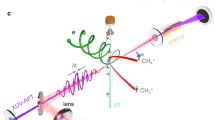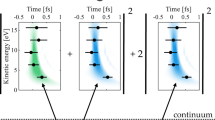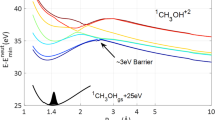Abstract
The interaction of an extreme-ultraviolet attosecond pulse with a molecular system suddenly removes electrons, which can lead to significant changes in the chemical bonding and hence to rearrangements of the residual molecular cation. The timescales of the electronic and nuclear dynamics are usually very different, thus supporting separate treatment. However, when light nuclei are involved, as in most organic and biological molecules containing atomic hydrogen, the correlation between electronic and nuclear motion cannot be ignored. Using an advanced attosecond pump–probe spectroscopic method, we show that the coupling between electronic and nuclear motion in H2 leaves a clear trace in the phase of the entangled electron–nuclear wave packet. This requires us to re-evaluate the physical meaning of the measured phase, which depends on the energy distribution between electrons and nuclei. The conclusions are supported by ab initio calculations that explicitly account for the coupling between electronic and nuclear dynamics.
This is a preview of subscription content, access via your institution
Access options
Access Nature and 54 other Nature Portfolio journals
Get Nature+, our best-value online-access subscription
$29.99 / 30 days
cancel any time
Subscribe to this journal
Receive 12 print issues and online access
$209.00 per year
only $17.42 per issue
Buy this article
- Purchase on Springer Link
- Instant access to full article PDF
Prices may be subject to local taxes which are calculated during checkout




Similar content being viewed by others
References
Hentschel, M. et al. Attosecond metrology. Nature 414, 509–513 (2001).
Sansone, G. et al. Isolated single-cycle attosecond pulses. Science 314, 443–446 (2006).
Eckle, P. et al. Attosecond ionization and tunneling delay time measurements in helium. Science 322, 1525–1529 (2008).
Schultze, M. et al. Delay in photoemission. Science 328, 1658–1662 (2010).
Klünder, K. et al. Probing single-photon ionization on the attosecond time scale. Phys. Rev. Lett. 106, 143002 (2011).
Månsson, E. P. et al. Double ionization probed on the attosecond timescale. Nat. Phys. 10, 207–211 (2014).
Guenot, D. et al. Measurements of relative photoemission time delays in noble gas atoms. J. Phys. B 47, 245602 (2014).
Palatchi, C. et al. Atomic delay in helium, neon, argon and krypton. J. Phys. B 47, 245003 (2014).
Kotur, M. et al. Spectral phase measurement of a Fano resonance using tunable attosecond pulses. Nat. Commun. 7, 10566 (2016).
Jordan, I. et al. Spin-orbit delays in photoemission. Phys. Rev. A 95, 013404 (2017).
Sabbar, M. et al. Resonance effects in photoemission time delays. Phys. Rev. Lett. 115, 133001 (2015).
Cattaneo, L. et al. Comparison of attosecond streaking and RABBITT. Opt. Express 24, 29060–29076 (2016).
Haessler, S. et al. Phase-resolved attosecond near-threshold photoionization of molecular nitrogen. Phys. Rev. A 80, 011404 (2009).
Sansone, G. et al. Electron localization following attosecond molecular photoionization. Nature 465, 763–766 (2010).
Calegari, F. et al. Ultrafast electron dynamics in phenylalanine initiated by attosecond pulses. Science 346, 336–339 (2014).
Huppert, M., Jordan, I., Baykusheva, D., von Conta, A. & Wörner, H. J. Attosecond delays in molecular photoionization. Phys. Rev. Lett. 117, 093001 (2016).
Remacle, F. & Levine, R. D. An electronic time scale in chemistry. Proc. Natl Acad. Sci. USA 103, 6793–6798 (2006).
Vibok, A. & Balint-Kurti, G. G. Parametrization of complex absorbing potentials for time-dependent quantum dynamics. J. Phys. Chem. 96, 8712–8719 (1992).
Cavalieri, A. L. et al. Attosecond spectroscopy in condensed matter. Nature 449, 1029–1032 (2007).
Locher, R. et al. Energy-dependent photoemission delays from noble metal surfaces by attosecond interferometry. Optica 2, 405–410 (2015).
Bandrauk, A. D., Chelkowski, S. & Nguyen, H. S. Attosecond localization of electrons in molecules. Int. J. Quant. Chem. 100, 834–844 (2004).
Calvert, C. R., Bryan, W. A., Newell, W. R. & Williams, I. D. Time-resolved studies of ultrafast wavepacket dynamics in hydrogen molecules. Phys. Rep. 491, 1–28 (2010).
Ranitovic, P. et al. Attosecond vacuum UV coherent control of molecular dynamics. Proc. Natl Acad. Sci. USA 11, 912–917 (2014).
Lara-Astiaso, M. et al. Decoherence, control and attosecond probing of XUV-induced charge migration in biomolecules. A theoretical outlook. Faraday Discuss. 194, 41–59 (2016).
Vacher, M., Bearpark, M. J., Robb, M. A. & Malhado, J. P. Electron dynamics upon ionization of polyatomic molecules: coupling to quantum nuclear motion and decoherence. Phys. Rev. Lett. 118, 083001 (2017).
Muller, H. G. Reconstruction of attosecond harmonic beating by interference of two-photon transitions. Appl. Phys. B 74, S17–S21 (2002).
Paul, P. et al. Observation of a train of attosecond pulses from high harmonic generation. Science 292, 1689–1692 (2001).
Ullrich, J. et al. Recoil-ion and electron momentum spectroscopy: reaction-microscopes. Rep. Prog. Phys. 66, 1463–1545 (2003).
Dörner, R. et al. Cold target recoil ion momentum spectroscopy: a ‘momentum microscope’ to view atomic collision dynamics. Phys. Rep. 330, 95–192 (2000).
Sabbar, M. et al. Combining attosecond XUV pulses with coincidence spectroscopy. Rev. Sci. Instrum. 85, 103113 (2014).
Wickenhauser, M., Burgdörfer, J., Krausz, F. & Drescher, M. Time resolved Fano resonances. Phys. Rev. Lett. 94, 023002 (2005).
Sanz-Vicario, J. L., Bachau, H. & Martin, F. Time-dependent theoretical description of molecular autoionization produced by femtosecond XUV laser pulses. Phys. Rev. A 73, 033410 (2006).
Kling, M. F. et al. Control of electron localization in molecular dissociation. Science 312, 246–248 (2006).
Palacios, A., Sanz-Vicario, J. L. & Martín, F. Theoretical methods for attosecond electron and nuclear dynamics: applications to the H2 molecule. J. Phys. B 48, 242001 (2015).
Lafosse, A. et al. Molecular frame photoelectron angular distributions in dissociative photoionization of H2 in the region of the Q1 and Q2 doubly excited states. J. Phys. B 36, 4683–4702 (2003).
Martín, F. et al. Single photon-induced symmetry breaking of H2 dissociation. Science 315, 629–633 (2007).
Sánchez, I. & Martín, F. Resonant dissociative photoionization of H2 and D2. Phys. Rev. A 57, 1006–1017 (1998).
Ito, K., Hall, R. I. & Ukai, M. Dissociative photoionization of H2 and D2 in the energy region of 25–45 eV. J. Chem. Phys. 104, 8449–8457 (1996).
Palacios, A., Feist, J., González‐Castrillo, A., Sanz‐Vicario, J. L. & Martín, F. Autoionization of molecular hydrogen: where do the Fano lineshapes go? Chem. Phys. Chem. 14, 1456–1463 (2013).
Bucksbaum, P. H., Zavriyev, A., Muller, H. G. & Schumacher, D. W. Softening of the H2 + molecular bond in intense laser fields. Phys. Rev. Lett. 64, 1883–1886 (1990).
Zavriyev, A., Bucksbaum, P. H., Muller, H. G. & Schumacher, D. W. Ionization and dissociation of H2 in intense laser fields at 1.064 μm, 532 nm, and 355 nm. Phys. Rev. A 42, 5500–5513 (1990).
Giusti-Suzor, A., Mies, F. H., DiMauro, L. F., Charron, E. & Yang, B. Dynamics of H2 + in intense laser fields. J. Phys. B 28, 309–339 (1995).
Wigner, E. P. Lower limit for the energy derivative of the scattering phase shift. Phys. Rev. 98, 145–147 (1955).
Argenti, L. et al. Control of photoemission delay in resonant two-photon transitions. Phys. Rev. A 95, 043426 (2017).
Sánchez, I. & Martín, F. The doubly excited states of the H2 molecule. J. Chem. Phys. 106, 7720–7730 (1997).
Latimer, C. J., Irvine, A. D., McDonald, M. A. & Savage, O. G. The dissociative photoionization of hydrogen via two-electron excitation at 27.5 eV and 30.5 eV. J. Phys. B 25, L211–L214 (1992).
Sánchez, I. & Martín, F. Dissociative photoionization of H2 and D2 by (30–37)-eV photons via 1Πu states. Phys. Rev. A 60, 2200–2206 (1999).
Aoto, T. et al. Dissociative photoionization of H2 at high photon energies: uncovering new series of doubly excited states. Chem. Phys. Lett. 389, 145–149 (2004).
Acknowledgements
This work is supported by the European Research Council (ERC) advanced grants ERC-2012-ADG_20120216 and ERC with grant agreement 290853 XCHEM within the Seventh Framework Programme of the European Union. We also acknowledge the financial support from the Ministry of Economy and External Trade (MINECO) projects FIS2013-42002-R and FIS2016-77889-R, and the European COST Action XLIC CM1204, and the computer time from the Centro de Computación Científica-Universidad Autónoma de Madrid (CCC-UAM) and Marenostrum Supercomputer. A.P. acknowledges a Ramón y Cajal contract from the Ministerio de Economiía y Competitividad (Spain). F.M. acknowledges support from the ‘Severo Ochoa’ Programme for Centres of Excellence in R&D (MINECO, Grant SEV-2016-0686) and the ‘María de Maeztu’ Programme for Units of Excellence in R&D (MDM-2014-0377).
Author information
Authors and Affiliations
Contributions
L.C., J.V., L.P. and S.H. performed the experimental measurements. L.C. and J.V. performed the experimental data analysis. R.Y.B., A.P. and F.M. performed the theoretical calculations and analysis. L.C., J.V., M.L., C.C., R.B., A.P., F.M. and U.K. contributed to the data interpretation, scientific discussion and to the manuscript.
Corresponding author
Ethics declarations
Competing interests
The authors declare no competing interests.
Additional information
Publisher’s note: Springer Nature remains neutral with regard to jurisdictional claims in published maps and institutional affiliations.
Supplementary information
Supplementary Information
Supplemenatry Chapters 1–6, Supplementary Figures 1–8
Rights and permissions
About this article
Cite this article
Cattaneo, L., Vos, J., Bello, R.Y. et al. Attosecond coupled electron and nuclear dynamics in dissociative ionization of H2. Nature Phys 14, 733–738 (2018). https://doi.org/10.1038/s41567-018-0103-2
Received:
Accepted:
Published:
Issue Date:
DOI: https://doi.org/10.1038/s41567-018-0103-2
This article is cited by
-
Attosecond delays between dissociative and non-dissociative ionization of polyatomic molecules
Nature Communications (2023)
-
Probing electron localization during molecular dissociation by femtosecond strong-field ion momentum spectroscopy
Communications Physics (2023)
-
Attosecond coherent control of electronic wave packets in two-colour photoionization using a novel timing tool for seeded free-electron laser
Nature Photonics (2023)
-
Attosecond photoionisation time delays reveal the anisotropy of the molecular potential in the recoil frame
Nature Communications (2022)
-
Influence of shape resonances on the angular dependence of molecular photoionization delays
Nature Communications (2021)



